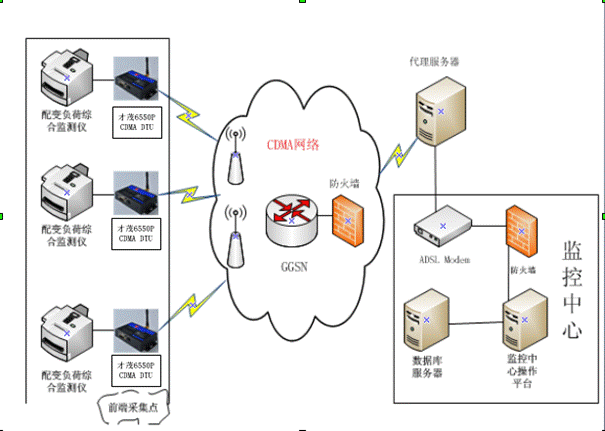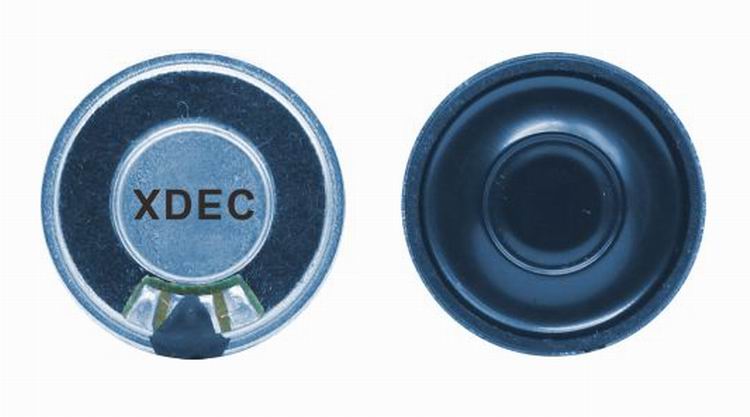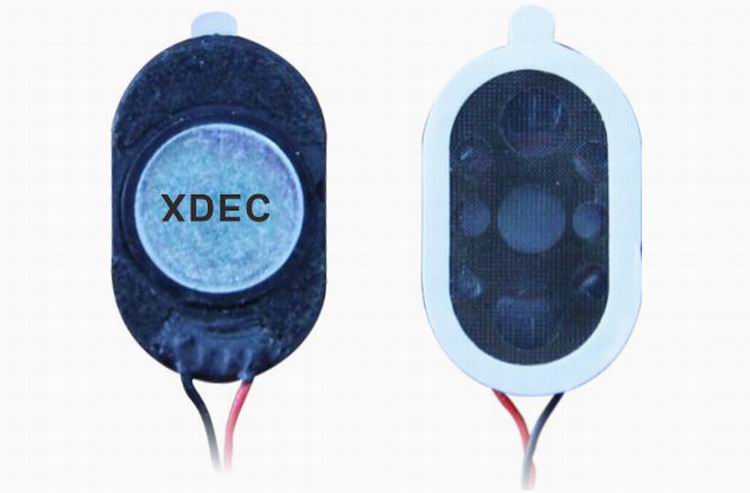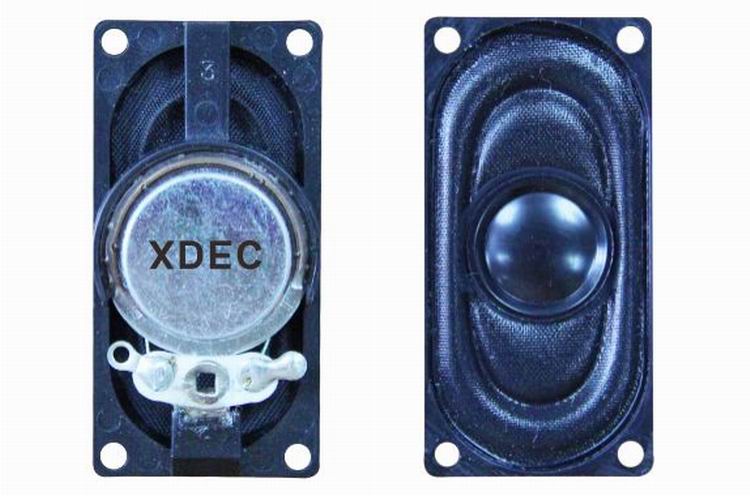This paper presents the design principle and implementation scheme of a CDMA-based power distribution monitoring system, briefly introduces the basic knowledge of CDMA technology, and describes the implementation method of CDMA wireless transmission applied to remote data monitoring. Through practical application, the ideal effect is obtained.
1. Foreword With the development of science and technology, the realization of the automation of medium and low voltage distribution networks has become the trend of power system development. As the last link of the transmission and distribution system, the medium and low voltage distribution network is closely related to the quality and reliability of power supply and use. For this reason, this article makes a brief discussion on the necessity of the automation of medium and low voltage distribution network and its implementation scheme.
A distribution transformer is a power device that distributes electrical energy directly to low-voltage users, and its operating data is an important part of the basic data of the entire distribution network. Therefore, it is necessary to monitor its operating parameters and status. This article discusses the use of CDMA as a means of communication to establish a monitoring system for distribution transformers.
In the communication of the distribution transformer monitoring system, data transmission radio stations, GSM short messages, optical fiber access, etc. can be used. The advantage of the digital radio station is that in addition to the annual frequency fee, there is no additional cost for normal operation; the disadvantage is that it is greatly affected by the terrain and climate, resulting in poor system reliability and real-time performance, and cannot be reported actively. The GSM short message method can achieve active reporting; the disadvantage is that it is charged on a per-item basis, the operating cost is high, and the delay is quite long when the server of the short message center is busy on holidays. Optical fiber communication is stable and reliable, but the construction cost is large, the scalability is poor, and the equipment maintenance is inconvenient. CDMA communication avoids the above problems.
CDMA is a new wireless data transmission service, which aims to provide users with high-speed wireless IP or X.25 services. The theoretical bandwidth of CDMA can reach 171.2Kbit / s, and the actual application bandwidth is about 40 ~ 100Kbit / s. TCP / IP connection is provided on this channel, which can be used for Internet connection, data transmission and other applications. CDMA uses packet switching technology, each user can occupy multiple wireless channels at the same time, the same wireless channel can be shared by multiple users, resources are effectively used. CDMA allows users to send and receive data in an end-to-end packet transfer mode without using network resources in circuit-switched mode. CDMA is always online, and charges are based on traffic, thus providing an efficient and low-cost wireless packet data service. It is especially suitable for intermittent, sudden and frequent, point-dispersed, small and medium-flow data transmission, as well as occasional large data transmission.
Second, the system structure The development goal of the distribution transformer integrated management system is to establish a safe and reliable, can provide various advanced services, and has an open platform that provides strong functions for the execution and implementation of application programs and many A relatively independent application subsystem system has become a distributed, open, modular, and expandable distribution transformer integrated management system that meets the modern management requirements of the distribution system. In addition to providing basic hardware technologies and operating system kernels, the basic platform also provides basic services such as database systems, information transfer, human-machine interfaces, and real-time environment applications. The application subsystems based on the basic platform include: distribution transformer management, line loss management, automatic meter reading, VQC function, harmonic data, power purchase management, data query, automatic reports, charts and interfaces with other systems, etc. . Between these subsystems, an organic horizontal and vertical integration is realized on the basis of an open system architecture (OSA) to form a complete distribution transformer integrated management information system.
The network architecture of the CDMA distribution transformer monitoring system is shown in the following figure. The system is divided into four parts, namely the monitoring center master station, network proxy server, CDMA data transmission terminal, and monitoring terminal equipment. The main station mainly completes the human-computer interaction work; the network proxy server is mainly responsible for the establishment of the network data link and the transparent transfer of data transmission and reception; the CDMA data transmission terminal completes the sending and sending of information; collection.
 . In this system, the network proxy server can be connected to the INTELNET public network such as ADSL, LAN, etc., using the fixed IP of the public network or the dynamic IP + DNS resolution service of the public network. For security reasons, the monitoring center master station is in the local area network, not directly In the INTERNET network, the network proxy server is responsible for the establishment of the network data link and the transparent transfer of data transmission and reception.
. In this system, the network proxy server can be connected to the INTELNET public network such as ADSL, LAN, etc., using the fixed IP of the public network or the dynamic IP + DNS resolution service of the public network. For security reasons, the monitoring center master station is in the local area network, not directly In the INTERNET network, the network proxy server is responsible for the establishment of the network data link and the transparent transfer of data transmission and reception.
After the CDMA data transmission terminal is powered on, it will actively access the network proxy server according to the preset IP address or domain name in its interior, and establish a TCP / IP link through the proxy server and the monitoring center. The main station of the monitoring center maintains the IP address and ID number of each terminal accessed. When the main station wants to make a data request to a certain monitoring terminal, it will find the corresponding terminal according to the IP address and ID number and issue the command Send to the terminal, after the terminal responds, send the data to the network proxy server port through the GRPS data transmission terminal, and forward it to the main station of the monitoring center through port mapping, that is, a response-type communication process is completed.
The above method is implemented through the Internet, so that the user implementation cost is relatively low. If high reliability data transmission is required. China Unicom provides direct access to the CDMA network for this application. The main station of the monitoring center directly accesses the CDMA Unicom base station through a dedicated line and obtains a fixed IP address. The monitoring point data does not need to be routed to the Internet network, and the monitoring point DTU also uses a SIM card with a fixed IP address. Using this method to form a point-to-multipoint network has the characteristics of good real-time and high security, but the access cost is relatively high.
Third, the monitoring terminal The monitoring system uses a comprehensive power distribution monitor is a high-tech product designed and manufactured according to the technical requirements of power demand side management and related standards for distribution transformer load monitoring. It uses high-precision digital sampling processing technology, integrates data collection, display, storage, communication and other functions in one, and can display, print and analyze the stored data in the form of charts or reports through background software. Its leading technology, powerful functions and high reliability can be widely used in the monitoring of distribution automation systems. Its main functions are:
Basic measurement parameters:
Three-phase voltage, current, frequency, active power, reactive power, power factor, four-quadrant energy, ambient temperature, etc., more than 30 parameters.
Technical parameters • Rated technical parameters Rated voltage Un: 100V
Rated current In: 5A
Rated frequency Fn: 50Hz
• Measurement accuracy Voltage / Current / Frequency: 0.2 level power factor / active power / reactive power: 0.5 level active power / reactive power: 1.0 level Electrical data recording (record every 15 minutes)
Accuracy voltage / current / frequency: 0.2 level power factor / active power / reactive power: 0.5 level active power / reactive power: 1.0 level system parameter setting device CT, PT variable ratio data storage interval system clock LCD contrast overvoltage Parameter undervoltage parameter overcurrent parameter 4. Data transmission terminal—Adopt CM 6550P CDMA DTU of Xiamen Caimao Communication Technology Co., Ltd.
CM 6550P CDMA DTU adopts ARM9 high-performance industrial-grade embedded processor, uses real-time operating system as software support platform, and embeds TCP / IP protocol stack with independent intellectual property rights. Provide users with high-speed, stable and reliable, data terminal always online, a virtual private network with multiple protocol conversions. For users of network flow control, the product supports the functions of voice, SMS, data triggering online and overtime automatic disconnection. At the same time, it also supports dual data center backup and multi-data center synchronous reception of data and other functions. The company's products have been widely used in finance, water conservancy, environmental protection, electricity, postal, meteorological and other industries.
1. Wireless parameters
1. Support IS-95 A / B and CDMA2000 1xRTT wireless network
2. Support 13K QCELP audio codec
3. Support data, voice, SMS and fax
Second, the hardware system
1. CPU: Industrial-grade high-performance ARM9 embedded processor, 200MPS, MMU, 16KB Dcache, 16KB Icache
2. FLASH: 8MB, expandable to 32MB
3. SDRAM: 64MB, expandable to 256MB
4. Interface:
1 RS232 serial port. (Support RS422 / RS485 as required), serial port rate 110 ~ 230400bits / s
Indicator: with power, communication and online indicator.
Antenna interface: Standard SMA female antenna interface, characteristic impedance 50 ohms.
UIM card interface: 3V / 5V standard push-type user card interface.
Power interface: standard 3-core locomotive power socket.
Voice interface: standard headset microphone interface.
5. Power supply:
External power supply: DC 9V 500mA
Wide voltage power supply: DC 5-35V
Communication current: 350mA
Standby current: 35mA
6. Size
Dimensions: 92.7x61.3x23 mm (excluding antenna and fixing parts)
7. Other parameters:
Working environment temperature -25 ~ + 65ºC
Storage temperature -40 ~ + 85ºC
Relative humidity 95% (no condensation)
3. Software function
1. Intelligent anti-drop, support online detection, online maintenance, automatic redial when dropped, to ensure that the device is always online.
2. Support RSA, RC4 encryption algorithm
3. Support virtual watchman VWM (Virtual Man Watch) function to ensure stable and reliable system
4. Support Virtual Data Private Network (APN)
5. Transparent data transmission and protocol conversion, supporting multiple working modes
6. Support data center dynamic domain name and IP address access
7. Support dual data center backup
8. Support multiple data centers
9. Support SMS, voice, data and other wake-up methods and timeout to disconnect the network connection.
10. Support short message backup and alarm.
11. Multiple hardware and software watchdog
12. Data packet transmission status report.
13. Standard AT command interface
14. Can be used as a normal dial modem
15. Support telnet function.
16. Support remote configuration and remote control
17. Software upgrade via serial port
18. Support both Linux and Windows operating systems
19. There are also software and hardware dual watchdogs, which can automatically power off and reset when the DTU cannot work normally.
4. The innermost layer of the main station system of the main station of the monitoring center is the operating system and system software. The second layer is the system support software layer, including database system, power system model, data collection and transmission. The power system model mainly refers to the objectification and network topology of power system equipment; the database system is divided into four parts: runtime library, basic library, standard library and history library; data collection and transmission is to collect various data from different terminals according to various communication protocols Come here, but do not process it, and then distribute it to the system that needs the data through the network. The third layer is the basic application layer. The collected data undergoes various processing and is displayed to the user through the GUI interface. The fourth layer is the advanced application layer. The data it generates is mainly used for further management and decision-making of the power supply system.
The host software mainly completes the following functions:
(1) Distribution transformer SCADA system transformer operation monitoring, transformer abnormal condition monitoring, data analysis, processing and storage, RTU parameter setting and status display. It can not only obtain the basic information of the distribution network operation, but also provide a good basis for the function expansion.
(2) The automatic meter reading system automatically records the distribution transformer and the user's electricity according to the set time. And it has auxiliary functions such as abnormal alarm of electric meter, tracking meter reading record and operation record.
(3) User power purchase management For users with poor reputation, the system purchases power first and then supplies power, and warns when the power consumption reaches a certain percentage.
(4) Line loss management is mainly line loss management and line line loss management in Taiwan.
(5) The management of distribution equipment is mainly the management of distribution lines and distribution transformers.
(6) Terminal error intelligent identification Terminal errors are divided into communication recovery, communication interruption (a terminal cannot be measured for three consecutive times), terminal wireless error (could not be measured for ten consecutive times a day), and wireless interruption (30 consecutive The terminal call cannot be measured).
(7) Load forecasting The initial load situation of the next stage is calculated by calculating the total active power addition of all stations in the main station and substation.
(8) The capacitor switching is adjusted locally according to the voltage and power factor, and the time factor and the number of switching are considered when adjusting. In the case of local adjustment failure, remote monitoring and remote control are possible. If the terminal has no regulation switching function, the system can control the capacitor switching after remote calculation.
(9) Terminal operation can remotely read or set terminal parameters, such as transformer setting parameters. The switch can be set to close and the switch to open. Can read or set VQC parameters.
(10) The interface with the marketing system database can easily provide a data source for the marketing system.
(11) Collecting harmonic data The system can collect the user's harmonic content through the system.
(12) User power stealing management Increase the comparison between user power and power conversion to power, and set a proportional coefficient to warn, for example, when active power is generated and the power does not move, a warning is generated.
5. Conclusion Realizing the automation of China's medium and low voltage distribution networks is a requirement to improve the quality of power supply, reliability of power consumption and the level of power companies themselves. As a new communication method, CDMA has many advantages in distribution automation The distribution transformer integrated management system of CDMA communication is a relatively promising implementation scheme.
Mylar speaker:
Mylar speaker is a kind of micro speaker unit which uses a diaphragm made of Mylar material. Mylar speakers are of ultrathin design and lightweight and clear voice. It is widely used in building security industry (e.g. intercom, video door phone, intelligent door control..), early education industry (storyteller, voice E-book, repeater, reading pen-), car electronics (GPS navigator, digital video recorder, radar detector-), medical devices (sphygmomanometer, glucometer, fetus-voice meter-) and mobile internet devices (tablet, notebook-).
There are two types of Mylar speakers from the shapes:
1) Round shapes, we have products from 10mm to 57mm in diameter.
2) Oblong shape, we have products in sizes of 1510/1712/1813-..




FAQ
Q1. What
is the MOQ?
XDEC: 2000pcs for one model.
Q2. What is the delivery lead time?
XDEC: 15 days for normal orders, 10 days for urgent orders.
Q3. What are the payment methods?
XDEC: T/T, PayPal, Western Union, Money Gram.
Q4. Can you offer samples for testing?
XDEC: Yes, we offer free samples.
Q5. How soon can you send samples?
XDEC: We can send samples in 3-5 days.
Mylar Speaker,Mylar Diaphragm Speaker,Mylar Membrane Speaker,Mylar Flat Speaker
Shenzhen Xuanda Electronics Co., Ltd. , https://www.xdecspeaker.com
